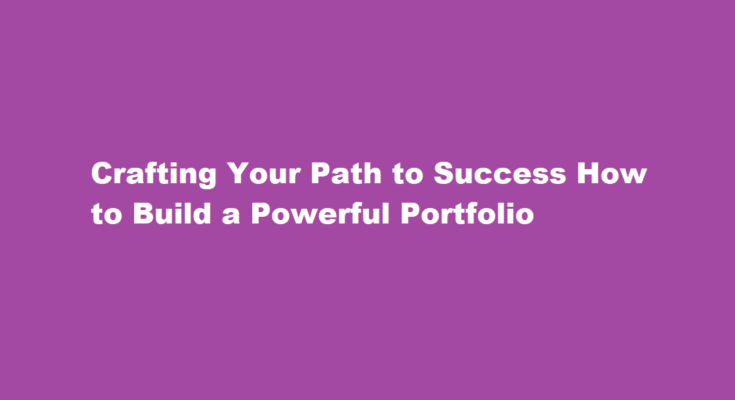In today’s competitive job market and creative industries, having a strong and well-crafted portfolio is essential for showcasing your skills, talents, and achievements. Whether you’re a budding artist, a seasoned professional, or a recent graduate looking to make your mark, a carefully constructed portfolio can be your ticket to success. In this article, we’ll delve into the art of building a portfolio that not only stands out but also reflects your unique strengths and aspirations.
Define Your Purpose
Before you dive into the creative process of building your portfolio, it’s crucial to define your purpose. Are you seeking employment in a specific industry, freelance opportunities, or looking to showcase your personal projects? Knowing your goals will guide the content and structure of your portfolio.
Select Your Best Work
Quality over quantity should be your mantra when choosing what to include in your portfolio. Select a range of pieces that demonstrate your versatility and proficiency. Be mindful of showcasing your best work, whether it’s a stunning graphic design project, a well-written article, or a successful marketing campaign.
Show Your Progress
If you’re a recent graduate or someone transitioning to a new career, it’s important to show your journey and development. Include personal projects, experiments, or coursework that highlights your growth and potential. It’s perfectly acceptable to mix professional work with personal projects to create a comprehensive narrative.
Tailor Your Portfolio to Your Audience
Consider who will be viewing your portfolio. Tailor your content to appeal to your target audience. For instance, if you’re applying for a graphic design position at a tech startup, emphasize projects that showcase your skills in web design or branding. Understanding your audience’s needs and preferences will make your portfolio more compelling.
Showcase Your Process
Incorporate your creative process into your portfolio. Include sketches, drafts, and progress shots to give viewers insight into your problem-solving abilities and workflow. Highlighting your process can differentiate you from other candidates and demonstrate your dedication to your craft.
Craft a Visually Appealing Layout
A visually appealing layout is crucial for capturing the attention of your audience. Choose a clean and organized design that complements your work. Avoid clutter and distractions, and ensure that your portfolio is easy to navigate. Remember, simplicity often leads to elegance.
Create a Compelling About Page
Your about page is an opportunity to tell your story and connect with your audience on a personal level. Share your background, interests, and what drives you as a creative professional. A well-written page can leave a lasting impression and make you more relatable.
Include Testimonials and Recommendations
If you’ve received positive feedback or recommendations from clients, colleagues, or mentors, include them in your portfolio. Testimonials add credibility and showcase your professionalism and teamwork. Potential employers and clients value the opinions of others who have worked with you.
Keep It Updated
Your portfolio should be a dynamic reflection of your skills and accomplishments. Regularly update it with your latest work, achievements, and experiences. An up-to-date portfolio demonstrates your commitment to your craft and staying relevant in your field.
Promote Your Portfolio
Building a portfolio is only half the battle; you also need to promote it effectively. Share your portfolio on professional networking sites like LinkedIn, on your personal website, and through your social media channels. Consider creating business cards with a QR code that links directly to your portfolio.
Seek Feedback
Don’t hesitate to seek feedback from peers, mentors, or industry professionals. Constructive criticism can help you refine your portfolio and make it even more impactful. Take feedback seriously and be willing to make necessary improvements.
Stay Authentic
While it’s essential to present your best work, it’s equally important to stay true to your style and identity. Authenticity is what sets you apart from the crowd. Don’t try to mimic trends or create work that doesn’t resonate with you. Your portfolio should reflect who you are as a creative professional.
Frequently Asked Questions
What is the first question you should ask yourself when creating an investment portfolio?
The most important question to consider before making any investment is, “What am I trying to accomplish?” Your investments will differ vastly if, for example, you are trying to save money for retirement versus trying to save money for a down payment on a house.
How do I make a beginners design portfolio?
Plan out all the necessary graphics, text, and pages before starting the design process. Showcase your talents. Make sure you add all the necessary contact information about yourself on the beginning or ending page of your portfolio. Keep your work relevant, organized, and consistent.
Conclusion
Building a portfolio is a strategic process that requires careful planning and curation. It’s your opportunity to tell your story, showcase your skills, and make a lasting impression on potential employers, clients, or collaborators. Remember, your portfolio is a dynamic tool that should evolve with your career. With dedication, creativity, and a commitment to excellence, you can craft a portfolio that propels you towards your professional goals and sets you on a path to success in your chosen field.
Read Also : Mastering The Art of Homemade Pasta A Delectable Journey



